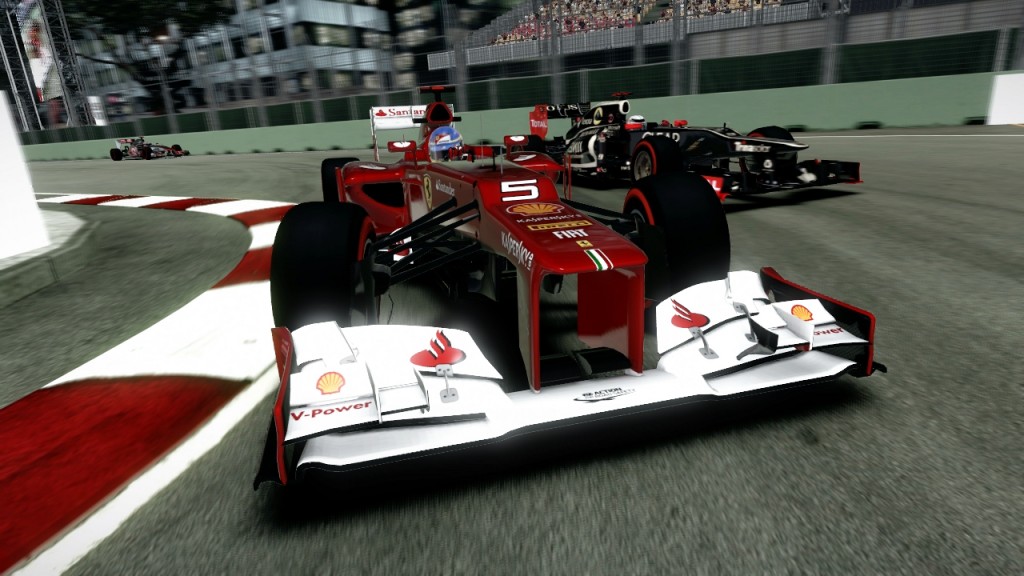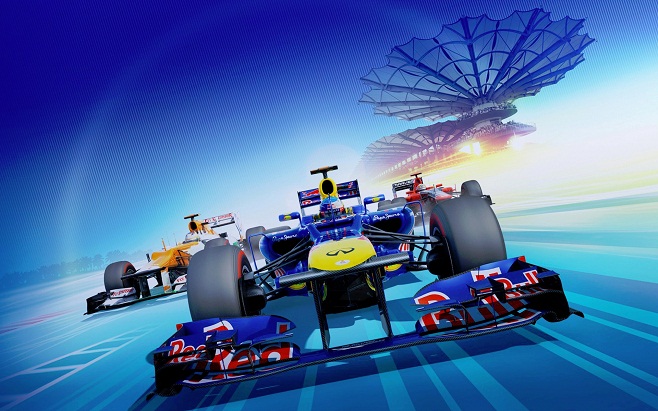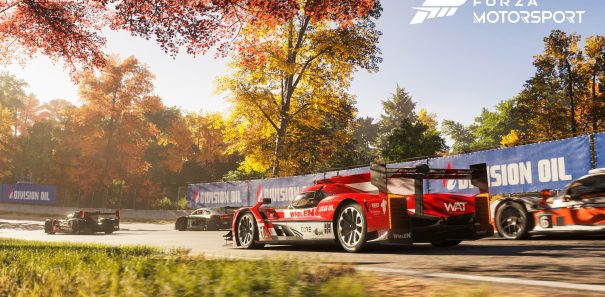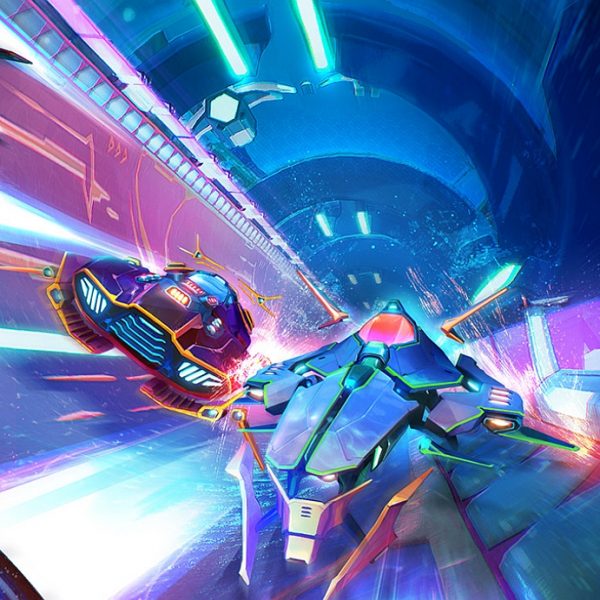While licenced games do have their obvious perks, one of the big fears around such titles is that, over a series, they can get a bit stale after a while: when a body governs how much you can get away with, it’s only a matter of time before you reach the edges of the box.
Check out any gaming forum, and one of the more recurrent themes is that F1 2011 did hit these metaphorical boundaries, with the consensus being that, while there were changes, it was debatable as to whether or not it was different enough to justify spending up to £40 on it.
And that’s where the new game steps in. The newly re-branded Codemasters Racing claims that, along with tweaks to the game’s core, F1 2012 marks a much more noticeable shift in how Formula One can be represented in a current video game, with new gameplay modes adding a new realm to a series that has previously been very focused on the career mode.
But are the words of the developers true? It’s time to find out…

Jumping into the hot seat
Fire the game up (and, if you’re impatient like me, skip through all the intro clips), and what instantly hits you is how different the menus are this time around. Gone is the paddock that has been such a prominent feature of previous titles, with the new layout being far more minimalist and simple. We can see where people are coming from when they say it’s “dull” and “clinical,” though – it’s by no means the most exciting user interface you’ll ever find in a game.
Sift your way through the menus, and you’ll eventually find yourself onto the new feature that response to all the people who hated the fact you had to be an F1 fan to get used to the game – Formula One is, after all, a pretty complex sport – it gives newcomers to the series a chance to get acclimatised on how to drive the cars.
However, while it was devised with good intent in mind, players of past titles or people who simply want to jump into the career mode will probably be a bit miffed that you have to complete the first of two ‘days’ before you can even start racing.
Still, the tests themselves aren’t tedious torture for those who’ll have the experience and speed to completely blitz the set targets and, if you complete both days, you’ll have access to three other teams to start your career in – Force India, Toro Rosso and Williams – on top of the ‘back of the pack’ outfits.
Out with the old, in with the new
One of the changes that Codemasters Racing didn’t announce until a week or so before the game was released was that the ‘Grand Prix’ mode – the part of the game that let you compete in a customised season as an F1 driver of your preference – had been scrapped. However, with the new elements in the form of Champions Mode and Season Challenge, it’s not like it’ll be sorely missed.
Part of the new push to make the game more appealing to those who can’t/don’t want to invest hours into a full race weekend or are part of the ‘pick up and play’ demographic, they are initially pretty solid new features: Champions Mode pits you against the six former World Champions on the grid across seven different events, whilst Season Challenge condenses the season down into ten 5 lap races with their own one-lap qualifying sessions.

However, dig a little bit deeper, and you start to see areas where improvement can (or should, depending on your viewpoint) be made. Even on the highest difficulty, it’s not too challenging to complete your objectives in both modes (we found the trickiest challenge in Champions Mode to be the race against Fernando Alonso, as it’s reliant on you winning the race as much as your digitally rendered Spanish team mate fending off the 22 other AI drivers), and both can get pretty repetitive after a while.
For instance, all the Champions events are simply just to finish ahead of your once triumphant team mate, with slight variations in all bar the finale that is the ‘Ultimate Challenge’, and no amount of restarting the Season Challenge will change the track line-up or weather scenarios for each race. Put simply, unless you’re a die-hard Trophy or Achievements collector or your game save data is lost or corrupted, there isn’t really that much incentive to replay the events again and again.
Still, it’s a solid first try from Codemasters, and we hope that in future Codies F1 games the mini- game modes evolve into something that’s a bit more challenging for the more hardcore players and more likely to encourage people to go back to them again and again.
Race day
Of course, casual modes aside, F1 2012’s true focus (as, indeed, it has been on pretty much every F1 game you can ever think of) is on the career mode; the true core of the gameplay. And, given that Codies has been continuously updating the career mode since the breath of fresh air that was F1 2010, it’s not too surprising to find that this is, by some margin, the best it’s been in the series so far.
Okay, so there’s nothing revolutionary about the way F1 2012 plays, and the changes made over F1 2011 aren’t initially apparent, but delve a bit deeper and you instantly notice what’s different this time around. Even on the PS3 version we’re testing (which, apparently, has the worst graphics of the PlayStation/PC/Xbox trio), the game is pretty amazing to look at. Our only major complaint is that the frame rate can stutter at times, but that’s often only when there’s a massive first corner pile-up. Other than that, it’s as smooth as silk.
As far as the physics go, again, there’s nothing radical, and even if you spent ages on the other gameplay modes the handling seems to change, with more understeer being dialed into the cars once you start the career mode (though this might just be us imagining things, and it’s nothing a few minutes spent tinkering in the garage can’t cure for the most part).

However, really concentrate and focus on setting clean and consistent laps, and you do start to notice pleasant and much-welcomed improvements. Yes, we’re a bit miffed with tyre management not playing as much of a part in full-length race weekends as we’d like, but there’s no denying that the more predictable and less-punishing handling – no doubt helped in part by the overhauled programming for the suspension – makes the cars far more approachable and exploitable than before.
management not playing as much of a part in full-length race weekends as we’d like, but there’s no denying that the more predictable and less-punishing handling – no doubt helped in part by the overhauled programming for the suspension – makes the cars far more approachable and exploitable than before.
That’s not to say Codemasters has tamed the gameplay down, though. Turn all the assists off, and you are well and truly left to your own devices. What once initially seemed like a tame pussycat with the traction control enabled is a feral beast that you really need to remain on top to stay on the tarmac. Long story short, this is the most hardcore Codemasters F1 game to date, and all but the most ardent of simulation fans should find plenty to like about the game’s physics.
And, of course, there’s the feature that pretty much defines the greatness of the game: when the virtual Heavens open up and completely drench the track. There isn’t a game on the market that takes wet weather racing and makes it about as perfect as we’re perhaps going to see on this generation of consoles. From the droplets of water dripping down from the screen, to the rooster tails sprouting from the rear tyres and being completely blinded by spray when you’re drafting the car in front, it showcases F1 2012 at its most thrilling and immersive.
Any downsides? Well, we never encountered the safety car outside of the Champions Mode so we can’t comment on that, and nor can we discuss the new location-based weather system, as every race we did was either on a bone dry or a completely sodden track, and the AI seem to have all the spatial awareness of Romain Grosjean at times. Upcoming console patches will at least partly rectify that problem, however, so it’s something we can put up with for now.

Oh, and we’re also really disappointed that the detail in the car models is almost let down by the really blocky and clunky decals and logos. Sure, they’re okay from a distance and when you’re racing on the track, but they’re impossible to ignore on the close-up shots during the replays.
The chequered flag
At first, we were both excited and anxious about all the changes we were told about pre-release that Codemasters would implement in F1 2012: we like evolution and changes, but there was always the fear that the game would follow in the footsteps of other racers that claimed to bring beneficial changes to the genre and series (*cough* Gran Turismo 5 *cough*), and fall flat on its face.
Thankfully, that isn’t the case with F1 2012. The new modes are a welcome breath of fresh air, though they do need a bit of refinement if Codemasters intends to develop them into more thorough and in-depth side missions that’ll draw players into them again and again in future titles, the core gameplay of the career mode has been fettled and tweaked into arguably the best it’s been in the entire Codies F1 series so far, and it’s easily the most accurate representation of the sport in any video game to date.
It’s not 100% perfect, and there are a handful of elements that look like they were pinched straight from F1 2011 (the on-track HUD, for instance, hasn’t been changed at all), but it’s easily the most comprehensive and accurate representation of Formula One that we’ve ever seen in a racing game. Even if you ignore the side missions, there’s still plenty to keep you occupied if you focus purely on full race weekends across the career mode.
Put simply, F1 2012 is a properly good game with enough changes to justify at least considering a purchase if you purchased F1 2011 (and certainly if you loved F1 2010 and didn’t opt for the sequel). It really is a very well sorted title that we expect will add quite a few BAFTA and gaming awards trophies to Codemasters’ ever-growing collection.




























